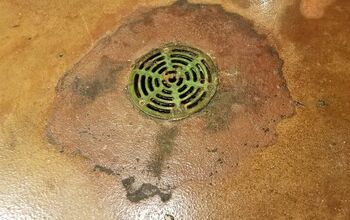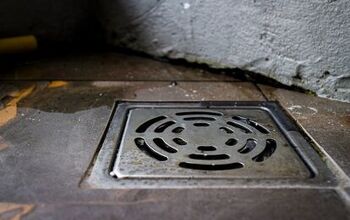Can I Cover A Basement Floor Drain? (Find Out Now!)

The hole in the middle of your basement floor serves an important purpose: to prevent flooding and water damage. Whether you have a washing machine, a sink, or a water heater in the basement, this drain plays a crucial role in making sure your basement doesn’t flood if something goes wrong. Furthermore, it prevents flooding from inclement weather since basements are situated underground.
This is why leaving it exposed is often a good idea. However, for various reasons, you may find yourself wanting to cover it. So, are you able to use a basement floor drain cover? We’re here to answer that for you.
You can cover a basement floor drain with a temporary cap or permanently with cement. The most common reasons you may want a basement floor drain cover includes protecting your space from sewage backflow that comes from old city sewer lines, blocking sewer smells, or as a part of the flooring installation for a basement finishing project.
In this article, we’ll discuss how your basement floor drain works and different ways to seal it. We’ll also talk about situations where you may not want to cover it after all. Let’s dive in, so you can make the right decision for your home.
Do You Need Foundation Drainage Installation or Replacement?
Get free, zero-commitment quotes from pro contractors near you.

Where Does Your Basement Floor Drain Go?
If you want to cover an existing basement floor drain, always check to see where the drain is leading. There are many different drainage systems and determining which one your basement has will affect your decisions about how and if you should cover your basement floor drain. There are three main forms of drainage commonly found in homes:
- City System: Most basement floor drains in houses are tied directly to the city sewer system. There is a pipe that leads directly to the main outlet.
- Sump/Sewer Pits: If your home’s plumbing is on a septic system, the water that enters your basement floor drain will go into a sump pit.
- Sewer Pits: If your basement is below the main sewer line, the water will go to a sewer pit where a pump will then push it back up to the sewer line.
How to Cover Your Basement Floor Drain
Unless you’re finishing a basement floor, you should veer toward using a temporary basement floor drain cover. Doing so allows you to properly maintain your floor drains and it also creates a solution that does not sacrifice the benefits floor drains provide.
That said, if you are sure that sealing the floor drain is something that you would like to do, then there are some ways to do that as well. Here are the two main methods for permanently or temporarily easing the basement floor drain.
Create a Seal
Let’s talk about sealing the floor drain first. In the event that you are finishing your basement, you may want to consider sealing the floor drain. If, for example, you are installing carpet, or do not want to have even the slightest risk of sewage backflow issues in your basement, then sealing the drain could be a viable solution.
When sealing a drain, it is best to use hydraulic cement. This can stop leaks in their tracks and ensure the seal will hold despite black flow pressure. Before you begin sealing, remove the grate and clear any debris. You’ll want to be careful once you start the actual sealing process as you’ll only want to cover the top 6 inches of the drain.
Use a Lid or Cap
It is important to keep in mind when sealing any drainage in your home that you or someone else in the future may want to regain access to it. This is why it’s often advisable to create a seal that is not permanent. Using a lid or a cap can help block gasses and stop backflows while still letting you use the drain when you need it.
There are a few different types of lids and caps you can use for your floor drain. These include test balls, twist plugs, and pressure plugs.
- Test balls have a round rubber end and a plastic cap. These plugs are preferred for older drains.
- Twist plugs are made with a metal or plastic cap and a rubber flange that fits inside the drain pipe. They come in various sizes and can be used for all different types of pipes
- Pressure plugs look similar to a wine cork and is kept in place with pressure. While they create an airtight seal, they may not be able to prevent backflows.
Common Floor Drain Issues
People often become interested in covering basement floor drains due to planned construction projects, such as finishing a floor. However, there are other reasons to consider covering a basement floor drain as well. Experiencing a bad smell coming from the sewer system is at the top of the list for many. Here are other common issues that unsealed floor drains cause.
Gasses
Sewer gas emission poses a serious problem in basements. As basements do not often feature good ventilation, sewer gases can build up inside of a home causing a major issue. While the problem is quite serious, the solution is simple.
Floor drains are built with traps meant to hold water. In cases when floor drains are not used for extended periods of time, the water inside of the trap can dry up. With no water left in the trap, gases inside the drainage system easily flow into the house.
Usually, all you need to stop sewer gas emissions is to pour some water into the trap. Obviously, this solution would be impossible if you were to cover the drain with anything permanent.
Clogging
The water draining through the drain is generally full of debris. This eventually builds up and clogs the pipe connected to the floor drain. Whether it’s from washing machines, water softeners, air conditioners, or any other major appliances, the combination of chemicals, soaps, and particulates in the water leads to clogging over time.
Whatever the cause may be, having access to the floor drain allows you to remove your blockages before they cause serious issues. A drain cover’s purpose is to stop large debris from entering the drain, so having one of those is a great way to avoid clogs.
In most cases, the best type you can buy is a polypropylene basement floor drain cover. Drain covers made from plastic materials do not suffer from the same problems as their iron counterparts.
Backflow
Another major concern connected to basement floor drains is backflow. Whether it is connected to a sewer, a sump pit, or a sewer pit, it is not uncommon to see backflow issues surface with basement floor drains. In most cases, backflow occurs from blockages and clogs in the main sewer lines.
When drain water has nowhere to go, it finds the nearest possible outlet which is, in most cases, the basement floor drain. An easy way to solve backflow issues in a basement floor drain to install a check valve. Also known as a backwater valve, the device can effectively stop any backflow from entering into your home through the basement floor drain. The valve activates when backflow curves and seals off the floor drain from within the pipes.
The Downside of Covering Your Basement Floor Drain
You will always find a basement floor drain in the lowest part of a structure. Floor drains serve two primary purposes, both of which are important.
First, floor drains are helpful in the event of a flood. Whether that flood is caused by water seeping into the house from outside or an appliance in the basement, any standing water will need somewhere to go. Since it is not advisable to leave a basement damp, having a water outlet is essential.
Floor drains also provide early warning signs for major problems that you need to address. Signs of potential issues may include septic tank back ups, sewer blockages, and much more. This will depend on where the basement floor drain goes.
Do You Need Foundation Drainage Installation or Replacement?
Get free, zero-commitment quotes from pro contractors near you.

So, Is It Safe to Have a Basement Drain Covered?
At the end of the day, it is safe to cover your floor drain. However, you should use a temporary lid or cap, so you can still use the floor drain in the case of a flood. If you’re finishing a basement, you may want to go for a permanent option instead. Either way, we hope this article has taught you a bit more about your floor drain as well as how and when you should cover it.
Related Guides

Benjamin is a proud homeowner who loves to write about DIY projects and home improvement projects. Traveling, perfecting his home, and spending time with his family are just a few of the many things that keep him inspired.
More by Benjamin Wright













![How Much Weight Can a 4×4 Support Horizontally? [It Depends!]](https://cdn-fastly.upgradedhome.com/media/2023/07/31/9070333/how-much-weight-can-a-44-support-horizontally-it-depends.jpg?size=350x220)
![10 Best Zero Turn Mowers – [2022 Reviews & Ultimate Buyer's Guide]](https://cdn-fastly.upgradedhome.com/media/2023/07/31/9070522/10-best-zero-turn-mowers-2022-reviews-ultimate-buyer-s-guide.jpg?size=350x220)












